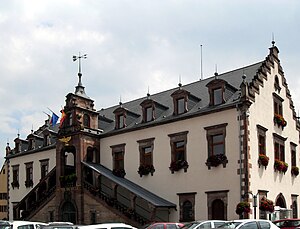Soultz-Haut-Rhin
| Soultz-Haut-Rhin | ||
|---|---|---|

|
|
|
| region | Grand Est | |
| Department | Haut-Rhin | |
| Arrondissement | Thann-Guebwiller | |
| Canton | Guebwiller | |
| Community association | Region of Guebwiller | |
| Coordinates | 47 ° 53 ' N , 7 ° 14' E | |
| height | 239-1,421 m | |
| surface | 29.56 km 2 | |
| Residents | 7,072 (January 1, 2017) | |
| Population density | 239 inhabitants / km 2 | |
| Post Code | 68360 | |
| INSEE code | 68315 | |
| Website | www.soultz68.fr | |
 Town Hall ( Hôtel de ville ) |
||
Soultz-Haut-Rhin (German: Sulz / Oberelsass ) is a French town with 7072 inhabitants (as of January 1, 2017) in the Haut-Rhin department in the Grand Est region (until 2015 Alsace ). It is part of the Arrondissement of Thann-Guebwiller , the canton of Guebwiller and a member of the Région de Guebwiller municipal association .
geography
Soultz is located at the foot of the Vosges , at the entrance to the Lauchtal (also called Florival ). The town, surrounded by vines, is located on the Alsace Wine Route . The urban area of Soultz extends to the Großer Belchen (French: Grand Ballon ), the highest peak in the Vosges (1424 m). The municipality is located in the Ballons des Vosges Regional Nature Park . Soultz (Haut-Rhin) station was on the Bollwiller – Lautenbach railway line .
history
The first written evidence of Sulza , which means something like "salted spring", can be dated to 667. At that time Soultz was dependent on the Ebersmunster Abbey . 350 years later (around 1015) Soultz belonged to the bishop of Strasbourg , later it belonged to the diocese of Basel . At the beginning of the 12th century, the knight-monks of the Order of St. John of Jerusalem (Order of Malta) founded their commandery in the north of Soultz. At that time Soultz was one of the ten most important commanderies in Alsace . This building now houses the “Nef des Jouets” (toy ship), a toy museum. Around 1250 a fortification wall was built around Soultz; Soultz then received city rights. Between 1322 and 1350 the city was hit by several plague epidemics. In addition, a great famine in 1337 led to the surrounding farmers besieging the city. In 1489 today's “Eglise St. Maurice” (Saint Mauritius Church) was completed; the second floor of the bell tower, however, dates from 1610. During the Peasants' War in 1525, the peasants managed to penetrate the city with the help of citizens and mainly raid and plunder the monasteries there.
During the Thirty Years War , the city was again hit by a series of calamities. In 1634 the population was decimated by another devastating plague epidemic; many of the survivors fled the city of hardship, fear and death. The almost uninhabited city was captured by the Austrians on February 4, 1634.
The annexation of Alsace to France in 1648 ( Peace of Westphalia ) had no influence on the way of life and the political structure. The town did not revive until the second half of the 17th century when new families, mostly Swiss, who had been driven out by Calvinism, moved to Soultz. It is worth mentioning a battle in 1652 when an attack by the Lorraine was repulsed. In their hasty escape, the attackers left their ladders leaning against the city walls and their fallen soldiers. The nickname of the Soultzer, "Babbaschlacker" ("Brei-Lecker"), also comes from this time. At that time Soultz was besieged by Swedish troops. The women were left alone while the men worked in the fields. When the attack began, the women threw a mixture of boiling oil and flour at the attackers to prevent them from storming the city.
Around 1770 Soultz finally experienced a new period of prosperity. Several beautiful buildings from this period bear witness to this. In the course of the French Revolution in 1789 all property of the church and the nobility were confiscated and the orders were dissolved. The Coming of the Order of Malta was sold and all the chapels were destroyed. Most of the arms of the noble families have disappeared and are lost forever. In 1796, Bishop Marc-Antoine Berdolet moved as a constitutional bishop to Soultz, which thus became the episcopal seat of the Haut-Rhin department . However, this episode ended as early as 1801 when Bishop Berdolet had to resign in accordance with the 1801 Concordat . In 1802 he was appointed the first bishop of the newly founded diocese of Aachen . Due to the Concordat, Soultz was removed from the diocese of Basel in 1802 and assigned to the diocese of Strasbourg .
After a whole quarter of old houses had been demolished, a new town hall was built on the market square in 1856. The large fountain, adorned with a statue of Saint Maurizius, dates from 1878. This gave the square its present appearance. Various factories were built in Soultz during the industrial age. An important silk weaving mill and foundry brought prosperity to Soultz, as a result of which the population rose to 3,000. The bourgeoisie participated in the urbanization of the city. In 1870 some incidents occurred with the advancing Prussian troops. Dr. West, the deputy mayor, took his own life because of a disagreement with the new authority. In 1880 Soultz had 4,000 inhabitants, four times more than in the 17th century. The importance of the craft workshops in the weaving and foundry sectors continued to grow. The workshops became factories; Telegraph and telephone were introduced. In 1898, water pipes were laid so that from then on households were supplied with running drinking water.
During the two world wars of the 20th century, Soultz was between the fronts. The heavy fighting over the nearby Hartmannswillerkopf mountain in the First World War took its toll with several dead and many houses destroyed. In 1917 the city was on the verge of evacuation, but this was ultimately not carried out. On November 17, 1918, French troops marched into Soultz again.
The city was hit hard by the economic crisis of 1932. Unemployment rose sharply and the city's budget collapsed.
During the Second World War , shells fell on the city again, killing several people. The Germans occupied the city again. On February 4, 1945 Soultz was liberated by French units of the 4th Moroccan Mountain Division.
Population development
| year | 1962 | 1968 | 1975 | 1982 | 1990 | 1999 | 2007 | 2017 |
| Residents | 4750 | 4910 | 5689 | 5696 | 5867 | 6640 | 7131 | 7072 |
Attractions
- The Gothic church of Saint-Maurice was built between 1270 and 1489.
- The castle Bucheneck is a Historical Museum.
- A toy museum ( Nef des Jouets ) is now housed in the former Commandery of the Order of Malta .
- Former synagogue on Rue du Temple
- Stork rearing
Parish partnership
Soultz has been related to the Italian municipality of Bonefro in the Molise region since 2016 .
Personalities
- François Jean Werlé (1763–1811), Brigadier General
- Eljakim Carmoly (1802–1875), scholar and literary historian
- Georges-Charles de Heeckeren d'Anthès (1812–1895), a French guard officer who was married to Katharina Goncharov, the older sister of Alexander Pushkin's wife . Pushkin was killed in a duel by his brother-in-law from Soultz.
- Auguste-César West (1810–1880), Prefect of the Haut-Rhin department from 1848 to 1850, then prefect of the Bas-Rhin department until 1855 and the Haute-Garonne department until 1859
- Pierre Villon (1901–1980), French politician and member of the Resistance
- Katia Krafft (1942–1991), volcanologist, grew up in Soultz. Wife of Maurice Krafft , also a volcanologist. Both came in 1991 during a volcanic eruption of Unzens in Japan , killed. Soultz Elementary School was named after them.
- Bernard Genghini (born 1958), footballer
literature
- Le Patrimoine des Communes du Haut-Rhin. Flohic Editions, Volume 2, Paris 1998, ISBN 2-84234-036-1 , pp. 1219-1246.


